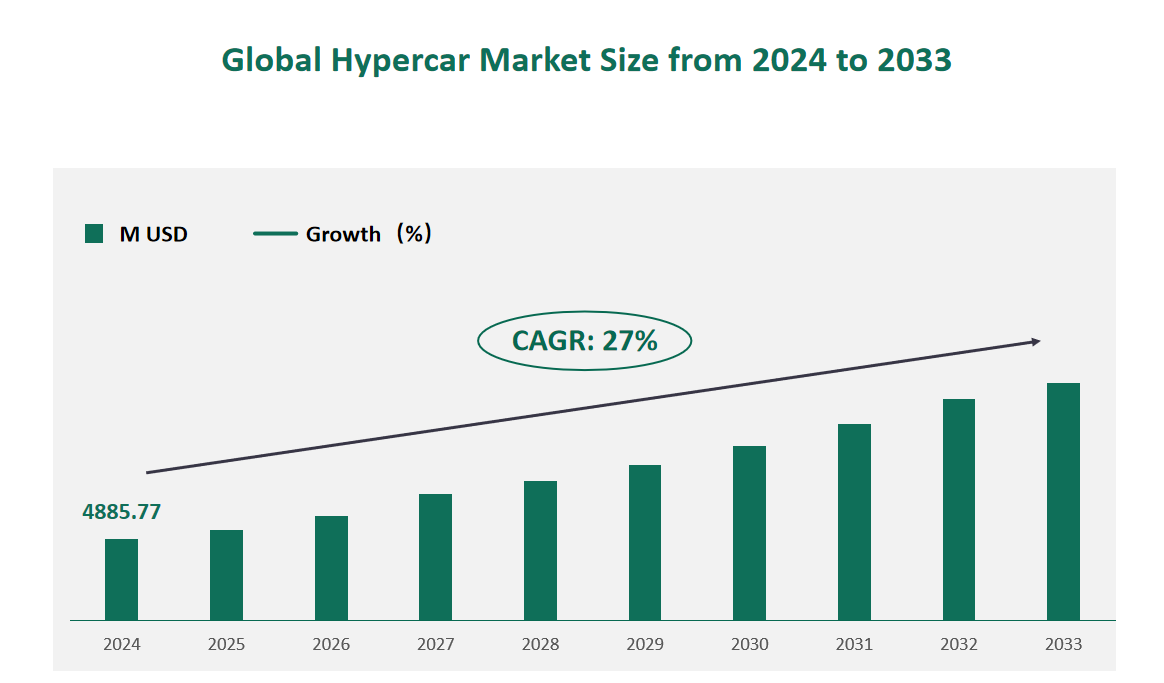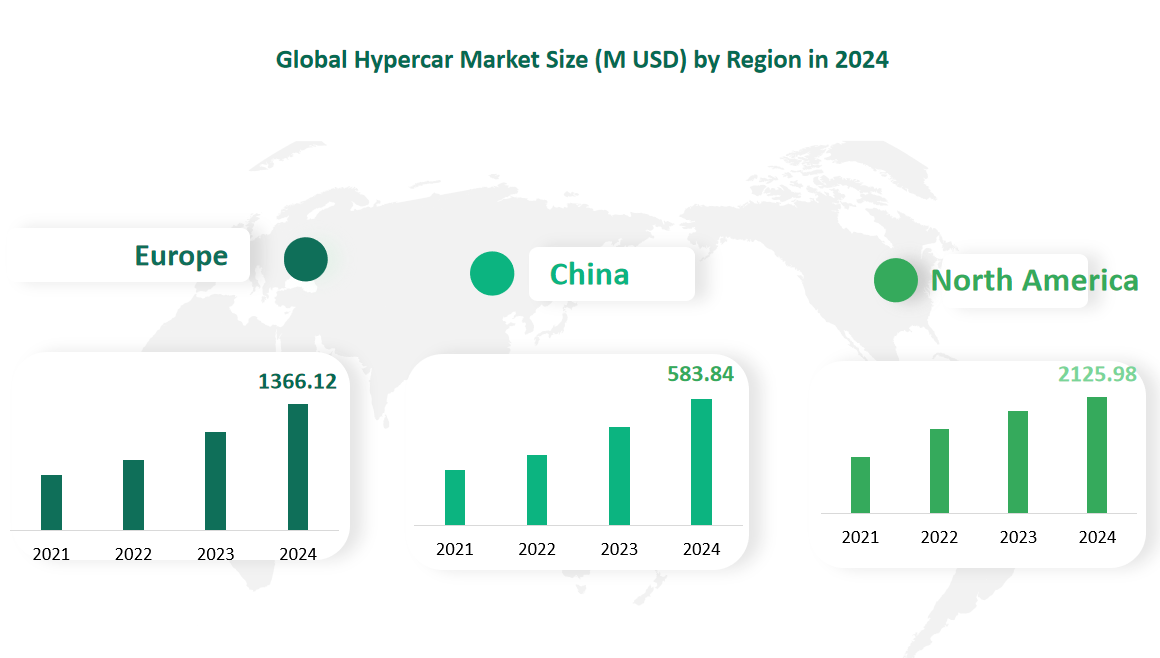1 Global Hypercar Market Size (Value) and CAGR (2024-2033)
In 2024, the global Hypercar market was valued at USD 4885.77 million, with a CAGR of 27% from 2024 to 2033.
Hypercar can be defined as the best and highest performance car in the global market. Hypercar has aerodynamic structure, low resistance function and excellent fuel economy. Smooth bottom, low-angle shroud and frame steam are products that contribute to the aerodynamic characteristics of Hypercar.
At the same time, hypercar is a top supercar, which surpasses all or most elements of standard supercar, including but not limited to acceleration, price, rarity, maneuverability, maximum speed, sound and appearance.
Figure Global Hypercar Market Size (M USD) and CAGR 2024-2033

2 Hypercar Market Drivers
One of the primary drivers of the Hypercar market is the increasing number of high-net-worth individuals globally. As economies grow and wealth accumulates, more consumers are able to afford these ultra-luxury vehicles. The demand for Hypercars is particularly strong among individuals who seek the ultimate driving experience and are willing to pay a premium for exclusivity and performance. This trend is evident in regions such as North America, Europe, and the Middle East, where the affluent population has a high propensity for luxury goods.
Technological advancements play a crucial role in the Hypercar market. The development of hybrid and electric powertrains has not only improved the performance and efficiency of these vehicles but also addressed environmental concerns. For example, electric Hypercars can achieve impressive acceleration and top speeds while reducing emissions. Additionally, innovations in materials science, such as the use of lightweight composites and carbon fiber, have enhanced the vehicles’ aerodynamics and overall performance. These technological advancements make Hypercars more appealing to consumers and contribute to the market’s growth.
The Hypercar market benefits from significant media attention and public interest. High-profile events such as auto shows, racing competitions, and new model launches generate buzz and attract enthusiasts and potential buyers. This increased visibility helps build brand prestige and reinforces the exclusivity associated with Hypercars. Furthermore, the competition among manufacturers to develop the most advanced and high-performing vehicles drives continuous innovation and improvement in the industry.
3 Hypercar Market Challenges
One of the primary challenges in the Hypercar market is the high cost of production. These vehicles require advanced materials, sophisticated engineering, and extensive manual labor, all of which contribute to their high price tags. The limited production capacity of Hypercar manufacturers further restricts the market’s potential. Most Hypercars are produced in small quantities, making it difficult to achieve economies of scale and reduce costs. This high cost of production limits the market’s accessibility to a broader consumer base.
The automotive industry is under increasing pressure to reduce emissions and adopt more sustainable practices. While many Hypercar manufacturers are investing in electric and hybrid technologies, the transition to zero-emission vehicles is challenging. The high-performance requirements of Hypercars often conflict with the need to reduce emissions, making it difficult to balance performance and sustainability. Additionally, regulatory requirements in various regions may limit the sale of traditional gasoline-powered Hypercars, forcing manufacturers to adapt their product offerings.
The Hypercar market is highly competitive, with a limited number of players vying for market share. Established brands such as Ferrari, McLaren, and Bugatti dominate the market, making it difficult for new entrants to gain a foothold. The intense competition can lead to market saturation, where the demand for new Hypercars may not keep pace with the supply. This situation can result in reduced sales and profitability for manufacturers.
4 Global Hypercar Market Size by Type in 2024
In 2024, the market value of Gasoline Hypercars is projected to be 1,153.96 million USD. Gasoline Hypercars are defined by their powerful internal combustion engines (ICEs), which deliver high horsepower and torque. These vehicles are known for their raw performance, with acceleration from 0 to 60 mph often achieved in under 3 seconds. Examples of gasoline Hypercars include the Ferrari 488 GTB and the McLaren 720S. Despite the growing trend towards electrification, gasoline Hypercars remain a significant segment, particularly among collectors and enthusiasts who appreciate the unique sound and power of ICEs.
On the other hand, Hybrid/Electric Hypercars are rapidly gaining market share. In 2024, the market value of hybrid/electric Hypercars is projected to be 2,141.35 million USD. Hybrid/Electric Hypercars combine the power of gasoline engines with electric motors or are fully electric, offering enhanced performance and reduced emissions. These vehicles leverage advanced technologies to deliver instant torque and improved efficiency, making them highly appealing to consumers who seek both performance and sustainability. Examples of hybrid/electric Hypercars include the Porsche 918 Spyder and the Rimac C_Two.
Table Global Hypercar Market Size by Type in 2024
Type | Market Size (M USD) 2024 |
Gasoline | 1153.96 |
Hybrid/electric | 2141.35 |
5 Global Hypercar Market Size by Application in 2024
In 2024, the global Hypercar market is expected to be dominated by Personal applications, with a market value of 4,784.72 million USD. Personal Hypercars are designed for individual use and are typically purchased by high-net-worth individuals who seek the ultimate driving experience. These vehicles are characterized by their exceptional performance, luxurious interiors, and exclusive designs. Examples of personal Hypercars include the McLaren 765LT, Ferrari SF90 Stradale, and Bugatti Chiron. The demand for personal Hypercars is driven by the growing number of affluent consumers, particularly in regions such as North America, Europe, and the Middle East, who are willing to invest in high-performance luxury vehicles.
On the other hand, Commercial applications of Hypercars are relatively smaller in scale, with a projected market value of 101.05 million USD in 2024. Commercial Hypercars are used for business purposes, such as corporate fleets, event management, and luxury transportation services. These vehicles are often customized to meet specific business needs and are designed to provide a high level of comfort and performance for passengers. The commercial segment is growing steadily, driven by the increasing demand for luxury transportation services in emerging markets and the need for high-performance vehicles in corporate fleets.
Table Global Hypercar Market Size by Application in 2024
Application | Market Size (M USD) 2024 |
Personal | 4784.72 |
Commercial | 101.05 |
6 Global Hypercar Market Size by Region in 2024
North America is projected to have a market value of 2125.98 million USD in 2024. The United States, in particular, is a major market for Hypercars, driven by a strong economy, a large affluent population, and a passion for high-performance vehicles. The market in North America is characterized by a high demand for luxury and performance, with consumers often seeking the latest technological advancements and exclusive designs.
Europe is another dominant region in the Hypercar market, with a projected value of 1366.12 million USD in 2024. Europe is home to many of the world’s leading Hypercar manufacturers, such as Ferrari, Bugatti, and McLaren. The region’s strong automotive heritage, technological expertise, and affluent consumer base contribute to its significant market share. European consumers are known for their appreciation of high-performance vehicles and often seek the latest innovations in automotive technology.
China is an emerging market for Hypercars, with a projected market value of 583.84 million USD in 2024. The growth of China’s middle class and increasing disposable income are driving the demand for luxury vehicles. The Chinese market is characterized by a growing interest in high-performance vehicles, particularly among younger consumers who are willing to invest in exclusive and technologically advanced cars. The government’s support for the automotive industry and the increasing presence of international brands in the Chinese market are also contributing to the growth of the Hypercar segment.
Figure Global Hypercar Market Size by Region in 2024

7 Major Players in Global Hypercar Market
7.1 Koenigsegg
Company Profile: Koenigsegg is a Swedish manufacturer of high-performance sports cars, founded in 1994 by Christian von Koenigsegg. The company is headquartered in Ängelholm, Sweden, and is renowned for its commitment to cutting-edge technology and design. Koenigsegg’s vehicles are characterized by their aerodynamic design, lightweight construction, and powerful engines, making them some of the fastest and most exclusive cars in the world.
Business Overview: Koenigsegg’s business model focuses on producing limited-edition, high-performance Hypercars that push the boundaries of automotive engineering. The company’s products are aimed at a niche market of enthusiasts and collectors who appreciate the brand’s dedication to innovation and performance. Koenigsegg also engages in research and development, contributing to advancements in automotive technology.
Product Introduction: One of Koenigsegg’s flagship models is the Koenigsegg Jesko. This Hypercar features a powerful twin-turbocharged V8 engine, delivering over 1,600 horsepower. The Jesko is designed for extreme performance, with a top speed exceeding 300 mph and acceleration from 0 to 60 mph in under 2.5 seconds. The vehicle also incorporates advanced aerodynamics and lightweight materials to enhance its performance and efficiency.
Recent Financial Performance: In the past year, Koenigsegg reported a market value of 335.40 million USD from Hypercar sales, with a gross margin of 61.78%.
7.2 McLaren
Company Profile: McLaren is a British automotive manufacturer with a rich history in motorsports. Founded in 1963 by Bruce McLaren, the company has expanded into producing high-performance road cars alongside its successful racing division. McLaren is headquartered in Woking, Surrey, England, and is known for its advanced engineering and design capabilities.
Business Overview: McLaren’s business strategy involves leveraging its expertise in Formula 1 racing to develop high-performance road cars. The company operates in three main divisions: Automotive, Racing, and Applied Technologies. McLaren’s road cars are characterized by their lightweight construction, powerful engines, and advanced aerodynamics, making them some of the fastest and most technologically advanced vehicles on the market.
Product Introduction: A standout model from McLaren is the McLaren Senna. This Hypercar is designed for extreme performance, with a top speed of 208 mph and acceleration from 0 to 60 mph in just 2.8 seconds. The Senna features a 4.0L V8 engine, delivering 789 horsepower, and incorporates advanced aerodynamic elements to enhance its handling and speed. The vehicle is also equipped with state-of-the-art technology and materials, ensuring a high level of performance and luxury.
Recent Financial Performance: Over the past year, McLaren reported a market value of 315.80 million USD from Hypercar sales, achieving a gross margin of 63.19%.
7.3 Aston Martin
Company Profile: Aston Martin is a British independent manufacturer of luxury sports cars and grand tourers. Founded in 1913, the company has a long history of producing high-performance vehicles with elegant designs and exceptional engineering. Aston Martin is headquartered in Gaydon, Warwickshire, England, and is known for its prestigious brand and commitment to luxury and performance.
Business Overview: Aston Martin’s business strategy focuses on producing luxury sports cars and grand tourers that combine elegance with high performance. The company’s products are aimed at a niche market of affluent consumers who appreciate the brand’s heritage and dedication to luxury. Aston Martin also engages in motorsports and racing, contributing to its brand prestige and technological advancements.
Product Introduction: One of Aston Martin’s notable models is the Aston Martin Valhalla. This Hypercar features a hybrid powertrain combining a twin-turbocharged V6 engine with electric motors, delivering over 1,000 horsepower. The Valhalla is designed for exceptional performance, with a top speed exceeding 200 mph and acceleration from 0 to 60 mph in under 3 seconds. The vehicle incorporates advanced aerodynamics and lightweight materials to enhance its performance and efficiency.
Recent Financial Performance: In the past year, Aston Martin reported a market value of 280.46 million USD from Hypercar sales, with a gross margin of 63.94%.

